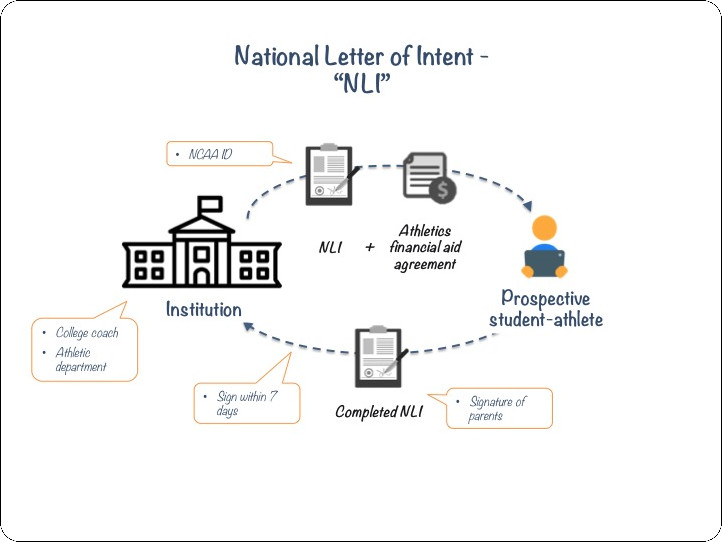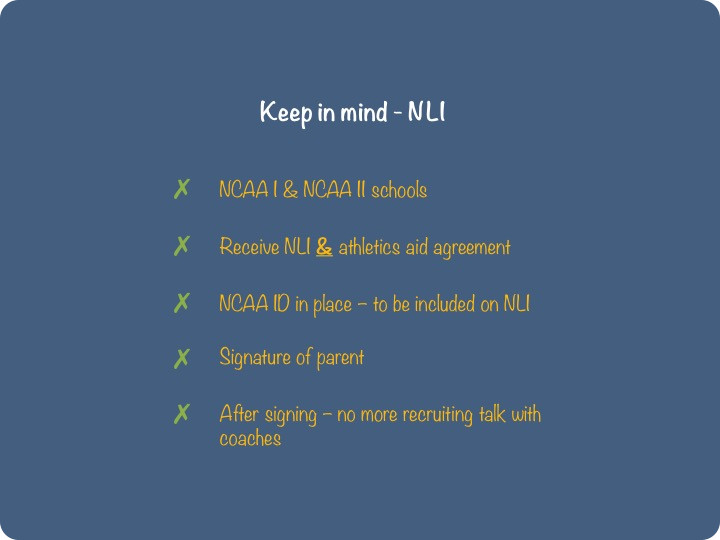5 Things You Need to Know Before Signing

Update: November 9, 2016
It's the time of the year when thousands of athletes of various sports sign their National Letter of Intent, or "NLI" in short. So do many teenage tennis players, eager to nail down their scholarship agreement and their spot in their future college team. So this is a time when a long and tedious recruiting process comes to a halt for many athletes. Hours of looking at schools, time spent writing e-mails and talking to coaches, and some more serious discussions with family and friends. For many players and future college students this has been a walk in the park, whereas others spent more time making up their minds. But whatever the story behind, once they sign an NLI, they are as good as through.
November 9 - the start of this year's early signing period, which goes on for a full week and ends on November 16. This blog today will therefore highlight some of the key features of the NLI. In detail, how the process works and 5 things you need to know about signing. Let's get started!
NLI procedure
The underlying procedure of sending and signing the NLI is actually a pretty straightforward 2-step format:
- The institution (recruiting coach's college) issues the NLI and the offer of athletics aid and sends these two documents to the prospective student-athlete.
- The future student-athlete signs the NLI in the correct way and returns it within the given time period (until November 16) to the institution. The college then undertakes the further required steps, but that's outside the athlete's control.
The graphic below outlines these two steps and highlights some of the things to keep in mind, which we cover below.

Important facts
There are obviously exact guidelines, which regulate the issuing of NLIs and the proper completion. As this blog edition is aimed at helping athletes (and their parents), we want to keep it simple and to the point.
- NLI member schools
The NLI is a voluntary program for NCAA D-I and D-II schools. As a result, not all of the institutions take part in the program. According to the NLI, 650 schools of these two divisions are members. This means that NCAA D-III, NAIA, and junior colleges are not using the National Letter of Intent. In addition, the Ivy League Schools (Harvard, Yale, Cornell, etc.) are prominent non-members. Why is that, you may wonder? Because NLI members need to be able to offer athletic scholarships, and Ivy League programs do not offer any athletics financial aid. - Documents
The school (the college coach) you are in contact with is required to issue the NLI and submit it to you together with an athletics financial aid agreement. The NLI needs to be dated and signed before sending it to the athlete. On top of that, it has to contain the athlete's ... - NCAA Eligibility
... NCAA ID. If you are in possession of a NCAA ID, this means you have completed the registration with the NCAA Eligibility Center. This also means that you have completed the section on the sports participation. Remember, this is the section with the questions on played tournaments, practice, or potential prize money/expenses; in other words you have established that you are an amateur in your sport. - Athlete under 21 years?
That's a simple one. Are you younger than 21 years old? Then you need to have one of your parents or another legal guardian sign the NLI as well. Most people are younger than 21 when starting college, so this is a very common requirement. - Recruiting ban
Once you have submitted and signed an NLI with a school, this effectively terminates all dialogue on potential scholarship offers with other coaches. The coach is permitted to say "hello and goodbye" and congratulate you, owed to the relationship you have established leading up to the signing period. But that's about it and coaches need to be extremely careful not to violate the recruiting ban regulations.

For a more detailed explanation coming straight from the organization behind the NLI, we highly recommend you take a look at the NLI's video:
Watching the video, you will also learn more about the consequences of signing an NLI. If you want to request a release of your commitment to a particular school, this has consequences regarding your eligibility to compete. Make sure you are aware of the consequences of your decision!
NLI in a nutshell
With all of that being said, what is the NLI all about?
"The NLI is a binding agreement between a prospective student-athlete and an NLI member institution.
Prospective student-athlete agrees to attend the institution full-time for one academic year (two semesters or three quarters).
Institution agrees to provide athletics financial aid for one academic year (two semesters or three quarters)."
It's a win-win for both sides. Signing an NLI in the early signing period, the athlete has secured a spot and financial support for his/her studies at a tennis program already now and can focus on finishing his/her studies as well as developing his/her game for the remainder of the time. For the coaches on the other hand, they are able to sign an attractive recruit well in advance - almost a year ahead - of the next full academic year.
We are naturally super excited, if we see posts like this pop up in our twitter timeline these days:
Congratulations to Isaac White, ROHS Tennis player, who signed with Arcadia University! #HawkTennis #NLI pic.twitter.com/abVq2WoEZR
? roisdathletics (@roisdathletics) July 29, 2015
Happy faces, happy recruits, happy parents, happy coaches, and hopefully dreams come true. That is really what keeps us from Smarthlete going ...
Do you want to bring yourself in position for a potential athletic scholarship and the next regular signing period starting in April 2017 or in the years to follow? Create a free recruiting profile on Smarthlete and reach out to as many coaches as you like in the easiest way possible! Not a student anymore, but interested in collegesports and in particular collegetennis? Follow us on our social media accounts, Facebook and Twitter, and don't miss out!